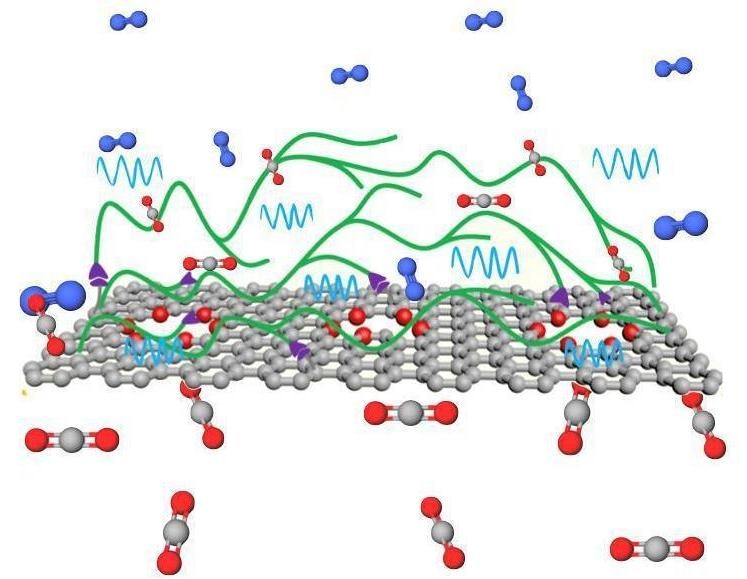Chemical engineers from EPFL have created a new class of high-performance membranes for trapping carbon that significantly crosses existing targets.
 CO2-selective polymeric chains anchored on graphene effectively pull CO2 from a flue gas mixture. (Image credit: KV Agrawal (EPFL))
CO2-selective polymeric chains anchored on graphene effectively pull CO2 from a flue gas mixture. (Image credit: KV Agrawal (EPFL))
Carbon dioxide (CO2), the main greenhouse gas generated from burning fossil fuels is still often liberated into the atmosphere, increasing the burden of global warming. Carbon capture is one method to decrease it and this chemical method eliminates CO2 out of emissions (“postcombustion”), stopping it from entering the atmosphere.
The captured CO2 can subsequently be either recycled or stored away in liquid or gas form via a process called sequestration.
Carbon capture can be performed using what are called “high-performance membranes,” which are polymer filters that can particularly isolate CO2 from a combination of gases, like those exiting a factory’s flue.
These membranes are eco-friendly; they do not produce waste, can strengthen chemical processes, and can be used in a decentralized manner. Actually, they are now regarded as one of the most energy-efficient ways of minimizing CO2 emissions.
Scientists headed by Kumar Varoon Agrawal at EPFL Valais Wallis have presently created a new class of high-performance membranes that crosses post-combustion capture targets by a considerable margin.
The membranes are based on single-layer graphene and have a selective layer with a thickness less than 20 nm. The membranes are highly tunable in terms of chemistry, implying that they can open the door for next-generation high-performance membranes for a number of critical separations.
Existing membranes must exceed 1000 gas permeation units (GPUs) and have a “CO2/N2 separation factor” greater than 20—a measure of their carbon-capturing specificity. The membranes created by the researchers at EPFL exhibit six times higher CO2 permeance at 6,180 GPUs with a separation factor of 22.5.
When the researchers integrated optimized graphene porosity, pore size, and functional groups (the chemical groups that actually react with CO2), the GPUs increased to 11,790 while other membranes they developed exhibited separation factors of up to 57.2.
Functionalizing CO2-selective polymeric chains on nanoporous graphene allows us to fabricate nanometer-thick yet CO2-selective membranes. This two-dimensional nature of the membrane drastically increases the CO2 permeance, making membranes even more attractive for carbon capture. The concept is highly generic, and a number of high-performance gas separations are possible in this way.
Kumar Varoon Agrawal, EPFL Valais Wallis
Source:
Guangwei He, Shiqi Huang, Luis Francisco Villalobos, Jing Zhao, Mounir Mensi, Emad Oveisi, Mojtaba Rezaei, Kumar Varoon Agrawal. High-permeance polymer-functionalized single-layer graphene membranes that surpass the postcombustion carbon capture target. Energy & Environmental Science 26 July 2019. DOI: 10.1039/c9ee01238a